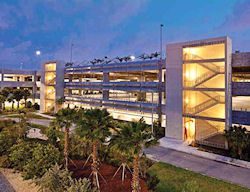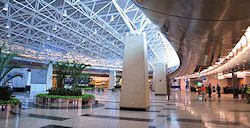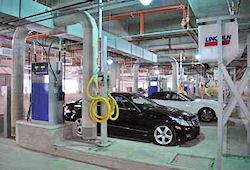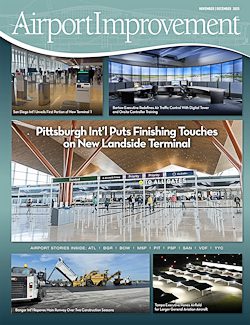 With room for 6,500 vehicles and 16 car rental companies, the new four-level, $383 million rental car center (RCC) at Miami International Airport (MIA) had an instant impact on the airport, passengers and surrounding streets when it opened in July.
With room for 6,500 vehicles and 16 car rental companies, the new four-level, $383 million rental car center (RCC) at Miami International Airport (MIA) had an instant impact on the airport, passengers and surrounding streets when it opened in July.
Gone is the “triangle” – 50 acres of individual car rental facilities sprawled around the airport. Gone is half of the airport’s 120-vehicle shuttle bus fleet. Gone is 15% of terminal core traffic and the congestion it caused.
 “The dispersed nature of the car rental companies was a point of dissatisfaction with passengers,” recalls Ray Diaz, chief of commercial operations at MIA. “After arriving at MIA, getting to a car rental company was one thing. But returning cars to the right places was confusing and a point of aggravation to everyone. The RCC will be a great convenience, and people avoiding the airport will come back.”
“The dispersed nature of the car rental companies was a point of dissatisfaction with passengers,” recalls Ray Diaz, chief of commercial operations at MIA. “After arriving at MIA, getting to a car rental company was one thing. But returning cars to the right places was confusing and a point of aggravation to everyone. The RCC will be a great convenience, and people avoiding the airport will come back.”
Dollar Thrifty Automotive Group reports increased space for employees as well as marked improvements in the customer drop-off process.
 With 3.4 million square feet of overall building space and a 130,000-square-foot lobby designed to serve 28,000 customers daily, the RCC is second in size in the United States only to the rental car center at Hartsfield-Jackson Atlanta International Airport. The 120 refueling stations located on various levels of the RCC, however, make it unique among U.S. airports. “You do not have to move entire fleets down to ground level for fueling. This improves the environment and the use of labor,” Diaz observes.
With 3.4 million square feet of overall building space and a 130,000-square-foot lobby designed to serve 28,000 customers daily, the RCC is second in size in the United States only to the rental car center at Hartsfield-Jackson Atlanta International Airport. The 120 refueling stations located on various levels of the RCC, however, make it unique among U.S. airports. “You do not have to move entire fleets down to ground level for fueling. This improves the environment and the use of labor,” Diaz observes.
Facts & Figures Project: Rental Car Center Location: Opened: July 13 Project Timeline: 2003-2010 Building Size: 3.4 million sq. ft. Site Size: 20 acres Cost: $385 million Owner: Designer/Builder: Contractor: Turner Construction Architect: Heery-S&G Project Manager: Tenants: Benefits: Key Elements: Noteworthy Details: Component Suppliers… Structural Reinforcements: Precast Structures: Post-tension Cable: DSI Concrete Mix: Tarmac Concrete Fuel Equipment: Spaceframe & Decorative Sunshades: Storefronts & Curtain Wall System: Trainor Glass Carwash Equipment: Belanger Fire Alarm System: Honeywell
One Cog in the Gear
Miami International Airport
Miami International Airport
Florida Dept. of Transportation
AECOM Construction, Engineering & Inspection Services: HNTB
16 rental car companies
Improved passenger experience; reduction of greenhouse gases
Four levels; aboveground fueling
Consolidation of multiple car rental companies; first multi-level fueling system in US.
Gancedo Rebar Services
Coreslab Structures
Talon Industries
Novum Structures
The Florida Department of Transportation (FDOT) conceived and built the RCC, and then conveyed it to the Miami-Dade Aviation Department. The new facility is the first stage of the Miami Intermodal Center (MIC), a comprehensive transportation hub that will offer residents and visitors train and bus connections between Fort Lauderdale, Miami, the various Palm Beaches and the Florida Keys.
The second stage of the MIC is a 1.25-mile people mover, which is scheduled to begin operating in late 2011. In the meantime, Los Angeles-based Tectrans will maintain and operate the airport’s shuttle bus fleet. Its contract includes hiring and training new drivers as well as selecting and refurbishing 70 of the airport’s best buses – 60 for active duty, 10 for spares. When the people mover begins operating and the shuttle bus fleet is completely retired, core traffic is expected to decrease by an additional 15%.
“The MIC will put us on a par with any metropolitan city in the world,” says Diaz. “It provides a mass transportation opportunity.”
As construction manager at risk for the project, Turner Construction Company guaranteed a maximum price for the specified scope of the work and guaranteed the duration of its work. “This was the largest project of my career and one of the largest ones ever for Turner,” says Turner vice president & general manager Jay Fraser.
In addition to constructing the RCC, Turner built roadways, performed site work, constructed bridges and built the elevated people mover station. At the peak of construction, 800 workers were on site. The RCC alone required 123,000 cubic yards of concrete and 7,200 tons of reinforcing steel. Turner also relocated water, sewer, gas and electrical lines throughout four city blocks.
Major improvements to the roadways associated with the MIC project have already had a positive impact, reports Gary Donn, FDOT’s director of transportation support and MIC program manager. Before a new road was completed in May 2008, the major north-south artery was one of the most congested highways in Florida, earning an “F” (the worst of six service grades) from the FDOT. It now rates a “B” and is free of airport traffic, Donn notes.
Treading New Ground
Managing the immense volume of construction fell to HNTB, the company FDOT contracted to provide construction, engineering and inspection services. For about 24 months at the middle of the job, the contractor was putting in $500,000 worth of work every week, recalls Albert Sosa, HNTB’s senior project engineer for the RCC. “We had to keep tabs on every concrete truck – 1,000 a month,” he relates.
Because there were no existing codes for the facility’s unique aboveground fueling system, HNTB hired global engineering giant ARUP to develop them. It produced four thick binders of codes to guide the design and construction of the system.
“It is a very complex and sensitive system,” Sosa explains. “There are a lot of layers of life safety, such as foam fire suppression, infrared detectors and vapor detectors. The fuel piping is double-walled, with air between the two pipes that detect drops in pressure due to leaks. If there is a fault in the system, a failsafe prevents fuel from being pumped. A whole layer of programming and electronics on top of the system track usage.”
Back on the ground level, Sosa observed improvements to road traffic first-hand, because he lives in the area. “Before, there was traffic all over the local roads and cars driving on local streets trying to find the highways,” he relates. “Now they have one point of access. It’s great.”
Aesthetics & Environment
 From the air, the RCC can be an overwhelming sight. But architects from Heery-S&G employed strategic design features to temper its visual impact on ground dwellers. Metal screening was specified over the broad stairwells to create an air of transparency. Open parking levels and curved stainless-steel louvers were used to reduce the building’s overall visual weight.
From the air, the RCC can be an overwhelming sight. But architects from Heery-S&G employed strategic design features to temper its visual impact on ground dwellers. Metal screening was specified over the broad stairwells to create an air of transparency. Open parking levels and curved stainless-steel louvers were used to reduce the building’s overall visual weight.
 “This humanizes the structure’s imposing façade and affords an elegant solution to a utilitarian structure,” explains Roberto Sequeira, Miami area manager and a vice president at Heery-S&G. “It makes a gesture of Miami’s recognizable features of natural light and openness. Lush landscaping softens the concrete facility.”
“This humanizes the structure’s imposing façade and affords an elegant solution to a utilitarian structure,” explains Roberto Sequeira, Miami area manager and a vice president at Heery-S&G. “It makes a gesture of Miami’s recognizable features of natural light and openness. Lush landscaping softens the concrete facility.”
Environmental design features include a system of carbon monoxide sensors and variable frequency fan drives that minimizes the power requirements of 35 large exhaust fans installed to keep the air fresh. The fans typically run at 30% capacity, but are boosted to 100% during peak traffic flow. In addition, 80% of the water used in the center’s 42 wash bays is recycled.
 When combined, the various design elements of the new RCC create a ripple effect of advantages. “The business enhancement is that the efficiency allows people to spend more time in the airport,” Diaz explains. “There will be more sales in the concession areas. More people will be able to use the airport, and more people can come to Miami.”
When combined, the various design elements of the new RCC create a ripple effect of advantages. “The business enhancement is that the efficiency allows people to spend more time in the airport,” Diaz explains. “There will be more sales in the concession areas. More people will be able to use the airport, and more people can come to Miami.”


